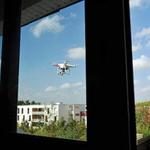
By Jonathan Zubair
One of the most revolutionary aspects of the recent rise in drone use is its widespread availability to the public. This easily accessible technology has spawned new and innovative uses for drones all over the world. Besides the domestic applications of drones, such as Jeff Bezo’s plan to deliver Amazon packages, drones still remain the subject of intense scientific study.
Of the many agencies currently involved in drone research and development, NASA has a developed a novel idea to implement drones in interplanetary research. NASA already uses drones such as Predators and Global Hawks here on Earth to conduct atmospheric tests, monitor wildfires, and many other remote observatory experiments, but now NASA is exploring drones as a method to explore other worlds.
One of the problems of conventional exploration rovers, such as the Mars rover Curiosity, is they are limited to the two dimensional landscape they explore. It follows that if there is an obstacle such as a mound or hill in front of the rover, the only way a rover can know what is beyond this hill is by observing satellites. Furthermore, because of this inability to gain insight into areas beyond its immediate vicinity, traditional rovers travel very slowly. As of last July the mars rover Curiosity traveled further than any other vehicle on another planet, traveling over 25 miles (40 km). However, Curiosity landed on Mars in January of 2004, meaning that the rover has averaged about 2.4 miles per year. Although this is an incredible accomplishment, engineers at NASA believe that drones can help accelerate this process.
This belief has led to the development of the Mars Helicopter at NASA’s Jet Propulsion Laboratories (JPL). This helicopter is a proposed ancillary for future mars rovers. This helicopter would land on Mars with a traditional rover and serve as a low altitude scout to help the rover determine what’s worth studying. These drones are not being designed to replace the scientific capabilities of large laboratory-like rovers, but instead they will provide insight into the immediate vicinity of the rover and help the science team on earth decide what’s worth exploring.
Designing aircraft for Mars flight is quite difficult, however, as there are many physical properties which will inhibit the drone’s ability to generate lift. The greatest challenge is the density of Mars’ atmosphere. Although the gravitational acceleration on Mars is only a little more than a third of what it is here on earth, Mars’ atmosphere is only one percent as dense as Earth’s. This poses a significant problem, as all turboprop and winged aircraft generate lift by compressing the atmosphere around them. This means that the less dense the atmosphere there is less lift that can be generated.
In order to determine the minimum requirements for lift on Mars, JPL’s Chief Engineer Bob Balaram and his team have been conducting experiments with small helicopters in a JPL vacuum chamber. The vacuum chamber is a perfect platform for this research as it can simulate the exact density of the Martian atmosphere. In order to generate more lift in such an environment, the rotors of the helicopter have to be bigger or spin faster. From these experiments Bob Balaram’s team found that given a rotor diameter of 3.6 ft. and a craft weight of 2.2 lbs. the necessary speed of the rotors to produce lift is about 2,400 rotations per minute.
Another significant obstacle is power. All of the power for the helicopter will be generated from solar cells. The energy generated by these cells must be able to power the helicopter on its daily flights and keep the craft warm during the cold Martian nights. Furthermore, since these helicopters will be making daily flights, they must be able to take off and land consistently, a challenging prospect given the rocky surface of Mars.
Should the Mars Helicopter meet its design objectives it will prove to be a remarkable asset to the rovers on the ground. These helicopters are designed to make daily flights, each lasting two to three minutes. In this time the drones can cover half a kilometer. This means that in 80 days these drones could cover as much distance as Curiosity has traveled in ten years. Although a ground rover would still have to travel to these locations to perform any scientific experiments, which would take significantly longer, JPL engineer Mike Meacham has said, “If our rover was equipped with its very own helicopter that could see over tall objects in front of it, it would allow us to make decisions much more efficiently on which way to command the rover.” Increasing the efficacy of this decision making will help the science teams on the ground decide which locations should be studied, and could ultimately lead to breakthroughs which would otherwise go unnoticed.
Although this technology is still being designed and tested, the Mars Helicopter might be ready for flying in time for the launch of the Mars 2020 Rover, which has a proposed launch date of summer 2020.


